1
Collie Woollen Mill c.1939Circa 1939
Appleton, Town of Mississippi Mills, Ontario, Canada
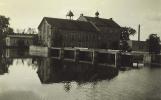 Credits:
Credits:North Lanark Regional Museum (2013.10.3)
Donated by Kenneth Godfrey
2
In 1937, the woollen mills of Appleton got a fresh start under the ownership of William Collie. The Collie family owned and operated the Woollen Mills for fifty years from 1937 until 1987. In 1947 the Collie family created Collie Woollen Mills Limited.3
Collie Woollen Mills Limited.Circa 1947-1987
Appleton, Town of Mississippi Mills, Ontario, Canada
 Credits:
Credits:North Lanark Regional Museum (2012.4.166)
4
William Collie was born in Scotland. He lived in Everdeen and worked in the textile industry. The Scottish Textile industry was hard work, low pay and there were no opportunities for advancements for the common worker. So in 1912 William Collie immigrated to Canada where he continued in the textile industry, this time with much more success.Arriving in Canada, William Collie was hired as a manager at the Pembroke Woollen Mills and worked there until 1917. During the Depression he worked a variety of jobs including operating a gas station but eventually he returned to the woollen industry and in 1933 purchased Ways Mill in Quebec.
In 1936 William heard of the empty woollen mill in Appleton and travelled there to see it. With the money he had saved while operating the mill in Quebec, Mr. Collie was able to purchase the mill from the Caldwell's and production began shortly afterwards.
5
Collie Children in Cainsville, Ontario, c.1920. L-R: Jim, Jack, Bill, Hank, JeanCirca 1920
Cainsville, Ontario, Canada
 Credits:
Credits:North Lanark Regional Museum (2012.49.6.2)
Donated by Isobel (Meabry) Collie in memory of her husband, John D (Jack) Collie, and his family.
6
The woollen industry was a family affair for the Collies. William's children:Bill Collie - worked in designs at the mill
Jim Collie - worked in sales at the mill
Jean Collie - worked in Administration and Accounting at the mill
Henry (Hank) Collie - work in sales for the mill
John (Jack) Collie - worked in New Brunswick at the associated Humphreys Woollen Mills
7
The Collie Family. Photo by Malak Karsh1945-1946
Appleton, Town of Mississippi Mills, Ontario, Canada
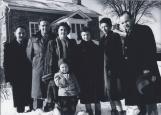 Credits:
Credits:North Lanark Regional Museum (2012.79.12.29)
Photographer: Malak Karsh
Donated by Eleanor Wright & Irene Dunn Thompson
8
Collie Woollen Mills in Appleton, Ontario. Photo by Malak Karsh1945-1946
Appleton, Town of Mississippi Mills, Ontario, Canada
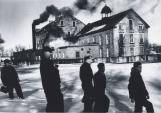 Credits:
Credits:North Lanark Regional Museum (2012.79.12.28)
Photographer: Malak Karsh
Donated by Eleanor Wright & Irene Dunn Thompson
9
The Caldwell Woollen Mill had lain dormant for several years and most of the skilled workers had moved to other mills or new jobs. In order to get the mills operating again the Collies needed mechanics, electricians, skilled looms people and weavers. Some of these positions were staffed by local residents who had worked at the Caldwell Mill, or had experience at mills in Carleton Place or Almonte, but even so more skilled labour was needed. Members of the Collie family travelled back to the U.K. to recruit more skilled workers. Employment at the mill was important to Appleton's economy. Once the small group of skilled workers got the mill functional more men and women from Appleton and the surrounding communities were hired and trained to work at the mill.The Collie Woollen Mill was a driving force in Appleton's economy.
10
Houses built by the Collie family in 1945 for mill employees. Photo by Malak Karsh1945-1946
Appleton, Town of Mississippi Mills, Ontario, Canada
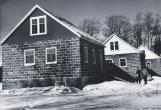 Credits:
Credits:North Lanark Regional Museum (2012.79.12.32)
Photographer: Malak Karsh
Donated by Eleanor Wright & Irene Dunn Thompson
11
Creating a functioning mill also meant fixing equipment and purchasing new machines as necessary. The equipment was typically North American made since the textile industry in the United Kingdom and Europe produced a different width of cloth. William Collie travelled to the Carolinas, Georgia and Tennessee to buy most of his equipment and would often bring his children along on these trips. When equipment broke down he Collie's often brought in technicians from the States to make the repairs.Mr. Collie also purchased equipment from closed mills.
12
One of the first things William Collie did when he acquired the Mill was to petition for hydro. At the time of purchase the mill was using electricity generated by a water turbine installed by the Caldwells. At the time, this turbine generator was the only source of electricity in Appleton and it generated power for the mill as well as limited power for a few houses and stores in Appleton.In 1937 the Collie Woollen Mill reached an agreement with Ontario Hydro Electric Power Corporation to have hydro brought to Appleton. In order to facilitate the agreement, the Collie's agreed to shut down their turbine generator so that Ontario Hydro would be the only supplier of electricity in Appleton. In 1937 Ontario Hydro build a dam on the Mississippi River, next to the woollen mill, in order to generate hydro-electricity.
In 1994, a newer hydroelectric facility was built on the Mississippi River on the site of the former Collie Woollen Mill. This new hydro dam uses three turbines and generators to produce an average of 6300 megawatt hours each year.
13
Woollen Mills, Appleton (Pre-1939). Waterwheel generator housed building on leftCirca 1880-1939
Appleton, Town of Mississippi Mills, Ontario, Canada
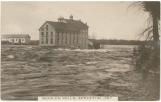 Credits:
Credits:North Lanark Regional Museum (2011.15.2)
Donated by Wendy Leblanc
14
Only two years after the Collie Woollen Mills began production World War Two began. The war was a major boost to the local economy. The mill shifted to 24 hour a day production in order to fill the military contracts. The mill produced woollens for uniforms, blankets and other military needs.The war deeply affected the community of Appleton as sons and daughters enlisted to protect their country while families worked extra shifts at the mill